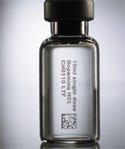Nonablating Laser System Targets Counterfeiting
October 15, 2007
Originally Published MPMN October 2007
BREAKTHROUGHS
Nonablating Laser System Targets Counterfeiting
|
The Validate system from ATS and Tesa embeds text, bar codes, and other marks onto glass vials and syringes. |
A marking system can create nonerasable logos, text, bar codes, and other supply-chain data by using a laser to bond transfer film to glass. The result of a partnership between ATS Automation and adhesive product specialist Tesa, Validate technology embeds high-contrast marks in the molecular structure of glass vials and syringes. Unlike standard laser-marking technology, Validate does not ablate glass. Marks produced by the system also resist abrasion, harsh chemicals, and high temperatures.
Capable of creating one- and two-dimensional bar codes, the technology can be used alone or in conjunction with RFID systems to combat drug counterfeiting. “While initially conceived as a marking technology to combat counterfeiting in nonmedical industries, the nonerasable nature of the Validate marking system allows the same anticounterfeiting properties to be used for pharmaceutical applications,” says Dave Adams, Tesa market manager.
Bar codes made by the system are compatible with standard scanner technology. The system is capable of embedding covert security features into the mark. Track-and-trace system functionality can be incorporated with the mark to guarantee to the end-user without a bar code reader that the vial or syringe originated in the intended supplier’s factory. Conventional paper labeling also can be used with the system.
Validate technology can be used with existing ink-jet infrastructure with minor positioning changes. Marking can be performed before washing and filling, or after filling and vision inspection. The marking speed varies according to the information printed; speeds as high as 400 vials or syringes/min are supported.
The marking technology can be tailored to the end-user’s application. For instance, line speed, information to be marked, material handling, changeover, line-management software, and other factors can be adapted to meet an individual customer’s needs. Suitable for cleanroom use, Validate marking technology can also be integrated with the firm’s Lyoscan vial inspection system. The machine’s control systems are compliant with 21 CFR Part 11 regulations.
ATS Automation, Cambridge, ON, Canada
www.atsautomation.com
Tesa, Sparta, MI
www.tesa.com
Copyright ©2007 Medical Product Manufacturing News
You May Also Like



